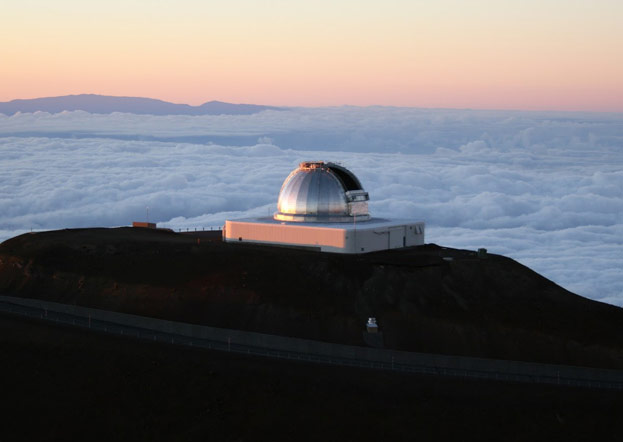
HOW?
IRTF
 NASA's InfraRed Telescope Facility is located at the summit of the (dormant!) Mauna Kea volcano in Hawaii, at an altitude of 4168 metres above sea level.
NASA's InfraRed Telescope Facility is located at the summit of the (dormant!) Mauna Kea volcano in Hawaii, at an altitude of 4168 metres above sea level.
This telescope has been tremendously useful for EuroVenus science observations, using several different instruments, using its 'resident' CSHELL and SpeX, as well as hosting 'visiting' instruments THIS, HIPWAC, and TEXES:
CSHELL is a is a 1 - 5.5 μm high resolution single-order echelle spectrograph. It has been used at Venus to measure, among other targets, mesospheric chemistry (Marcq et al. 2013) and upper atmosphere airglow (Ohtsuki et al., 2013).
SpeX is a medium-resolution 0.8-5.5 µm cryogenic spectrograph. It has been used, in particular, for sounding of the lower atmosphere ('troposphere') of Venus using thermal infrared light escaping through the clouds on the nightside of the planet (e.g. Marcq et al. 2008).
The Texas Echelon-cross-Echelle Spectrograph (TEXES) is an infrared imaging spectrometer operating between 5 and 25 μm which combines high spatial (about 1.5 to 2 arcsec) and spectral (R = 80 000) resolution.
The Tunable Heterodyne Infrared Spectrometer (THIS is a heterodyne spectrometer in the range 7-17 µm, developed by EuroVenus consortium members at the University of Cologne. Heterodyne spectrometry allows extremely high spectral resolution, that is the ability to distinguish narrow features in the observed spectrum of light. This enables sensitive measurement of gas species; measurement of atmospheric temperature structure by detailed study of the spectral line shapes; and direct measurement of winds by examining the Doppler shift of spectral lines. Note that the THIS instrument is compact and portable, it is used also at other observatories like the Kitt Peak Observatory.
The Heterodyne Instrument for Planetary Wind And Composition (HIPWAC) is another portable heterodyne spectrometer (at 7-13 µm) which offers extremely high spectral resolution, this time developed at NASA Goddard Space Flight Centre. EuroVenus consortium members have worked extensively with the HIPWAC team, on science goals including similar to those targeted by the THIS instrument.

This telescope has been tremendously useful for EuroVenus science observations, using several different instruments, using its 'resident' CSHELL and SpeX, as well as hosting 'visiting' instruments THIS, HIPWAC, and TEXES:
CSHELL is a is a 1 - 5.5 μm high resolution single-order echelle spectrograph. It has been used at Venus to measure, among other targets, mesospheric chemistry (Marcq et al. 2013) and upper atmosphere airglow (Ohtsuki et al., 2013).
SpeX is a medium-resolution 0.8-5.5 µm cryogenic spectrograph. It has been used, in particular, for sounding of the lower atmosphere ('troposphere') of Venus using thermal infrared light escaping through the clouds on the nightside of the planet (e.g. Marcq et al. 2008).
The Texas Echelon-cross-Echelle Spectrograph (TEXES) is an infrared imaging spectrometer operating between 5 and 25 μm which combines high spatial (about 1.5 to 2 arcsec) and spectral (R = 80 000) resolution.
The Tunable Heterodyne Infrared Spectrometer (THIS is a heterodyne spectrometer in the range 7-17 µm, developed by EuroVenus consortium members at the University of Cologne. Heterodyne spectrometry allows extremely high spectral resolution, that is the ability to distinguish narrow features in the observed spectrum of light. This enables sensitive measurement of gas species; measurement of atmospheric temperature structure by detailed study of the spectral line shapes; and direct measurement of winds by examining the Doppler shift of spectral lines. Note that the THIS instrument is compact and portable, it is used also at other observatories like the Kitt Peak Observatory.
The Heterodyne Instrument for Planetary Wind And Composition (HIPWAC) is another portable heterodyne spectrometer (at 7-13 µm) which offers extremely high spectral resolution, this time developed at NASA Goddard Space Flight Centre. EuroVenus consortium members have worked extensively with the HIPWAC team, on science goals including similar to those targeted by the THIS instrument.

